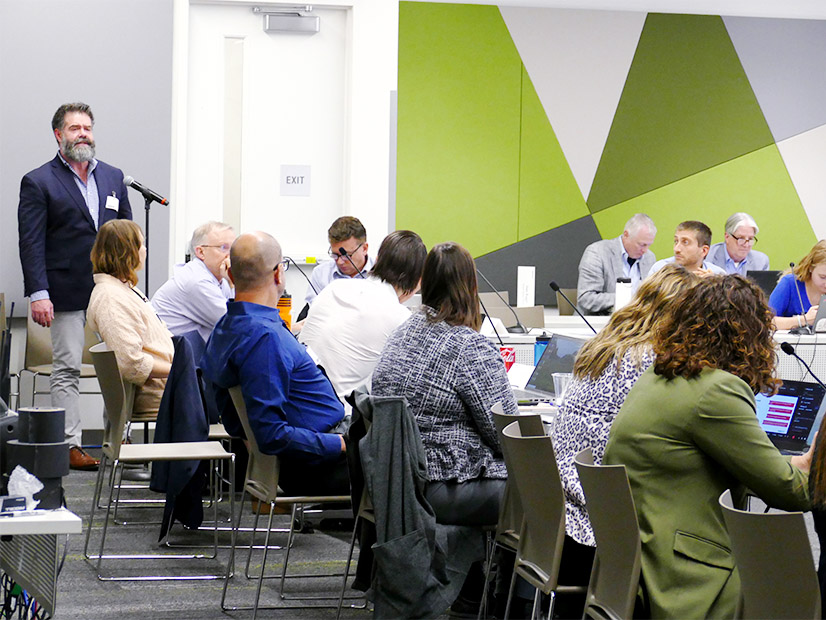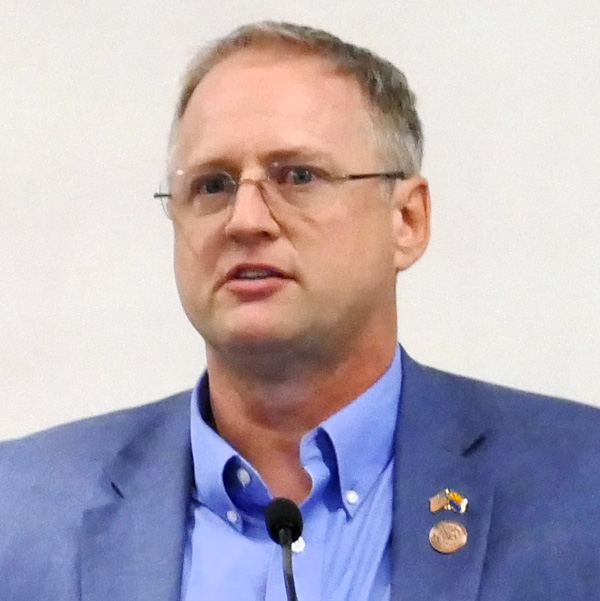TEMPE, Ariz. — Stakeholders interested in participating in SPP’s Markets+ service offering in the Western Interconnection last week approved much of the draft tariff language they’ve developed together in recent months.
That tickles SPP attorney Chris Nolen, whose frequent comments about building “the best tariff ever” are being repeated by SPP staff and potential western stakeholders.
“We’ve moved, in my opinion, more efficiently, faster, better than I thought we would when we had our kickoff meeting,” he said during a break in the Nov. 7-8 Markets+ Participant Executive Committee (MPEC) meeting. “It’s been super impressive how all the market participants, everybody involved at all the stakeholder groups picked up really quickly on how it works, how it runs, how you make comments, how you get changes you want to see in the tariff language. I think we’re in an excellent spot.”
MPEC members endorsed chunks of tariff language that define how the day-ahead Markets+ will handle market transmission use, congestion management, transmission capacity obligations, market manipulation and confidentiality. The Interim Markets+ Independent Panel (IMIP), composed of three SPP directors, added its approval as well.
However, the Markets+ Greenhouse Gas Task Force was given up to eight weeks to approve draft language incorporating GHG emissions-related information in the market’s reporting, price formation, commitment and dispatch. The group already has a conceptual framework.
The Pacific Northwest’s only cap-and-trade program, Washington state’s cap-and-invest initiative, has a Nov. 1, 2024, compliance deadline. By that time, affected entities need to have enough allowances to cover 30% of their 2023 emissions. (See “GHG Issue: ‘Emissions Leakage’,” Markets+ Stakeholders Begin Tariff’s Development.)
A proposed option of making a supplemental filing at FERC once the cap-and-invest program’s rules become clear failed to garner enough support. Washington’s Department of Ecology, which is overseeing the program, has an ongoing rulemaking to be completed next summer.
Task force chair Mary Wiencke, with The Public Generating Pool, said she expects the rulemaking to be delayed by Ecology’s concerns over Markets+’s final market design.
“There’s a real cart-before-the-horse and a real chicken-and-egg issue here,” Wiencke said. “Somebody has to go first, and so then the rules in the market design have to be jointly sort of put together. … We need a market design to have rules also. This process is going to be iterative, no matter what.”
“When you do that four to six weeks, or four to eight weeks, the pressure is really on all of us because we know that there’s a pretty significant consequence if we don’t get there,” PowerEx’s Mark Holman said. “We’re either [filing a supplemental] or we’re into a tariff delay that affects everything in this initiative. I like that pressure being on. I think it’s worked well. We will have different resources that roll their sleeves up and not sacrifice the quality of the solution, but actually get it done.”
The GHG delay could throw a kink in SPP’s plans to have the tariff complete in December and take it to the RTO’s Board of Directors in February. SPP hopes to receive IMIP approval Dec. 14 before taking it to the board; the tariff would be filed in the first quarter next year, assuming final approval.
The task force will report on its progress during MPEC’s Dec. 6-7 virtual meeting, which once was a one-day call.
“We want to have the tariff and all the policy items done by December,” said Carrie Simpson, SPP’s director of seams and western services development. “However, to the extent that we’ve got some stuff that’s still hanging around or there’s a policy item that needs extra time, I don’t know that January’s a [hard deadline].”
No need to worry about the additional time afforded to the GHG task force, Nolen said.
“It’s just complex, so it’s taken a little bit when you plug it in to the broader market,” he said. “It’s new. We’ve never had to plug one in yet.”
Nolen told MPEC if SPP receives the GHG tariff language in mid-January, staff will need only a week to “holistically consider” the tariff and to file at FERC.
“If we tried to wait and amend the filing after the fact, that brings up some of the complications with pushing this date,” he said. “When the pens go down, we need eight weeks internally to run through that tariff and be sure that we wired everything out to the baseline tariff and everything works.”
“The degree of collaboration and consensus that’s been required to develop this volume of tariff language this quickly is tremendously encouraging,” Antoine Lucas, SPP’s vice president of markets, said after the meeting. “SPP and the Markets+ participants are striking a remarkable balance between speed and meaningful consideration in developing a market that works for all stakeholders.”
FERC’s approval of the Markets+ design would begin the market’s second phase of development. At that point, SPP would acquire the necessary software and hardware, participating entities would fully commit to funding the market and they would be integrated into the system.
Go-live is targeted for October 2026.
WRAP, RTO West Advance
SPP also celebrated recent “significant” progress with the other prongs of its western expansion. It said an important element of the Western Power Pool’s Western Resource Adequacy Program (WRAP) that it operates became operational Nov. 1, and the grid operator formally kicked off its RTO West development in Denver.
WPP says the WRAP is the first regional reliability planning and compliance program in the history of the West. Its operations program produces updated forecasts each season to help determine whether participants will have sufficient resources and enables those with a deficit to secure additional resources.
The RTO said the program will remain non-binding for an undefined time.
“SPP is grateful for our partnership with Western Power Pool and the opportunity to help assure resource adequacy for their member utilities,” Casey Cathey, SPP’s senior director of grid asset utilization, said in a statement.
On Nov. 9 in Denver, SPP hosted utilities that have committed to joining as members of its RTO in the Western Interconnection. The grid operator presented its plan to coordinate the utilities’ integration into SPP’s planning, reliability coordination, market and other services before operations are targeted to begin in April 2026. (See WAPA, Basin Electric Commit to SPP’s RTO West.)
SPP’s senior vice president of operations Bruce Rew, who leads the RTO expansion program, said the kickoff was a result of years of negotiations and planning.
“We’re eagerly looking forward to the day that these plans come to fruition and we have the opportunity to bolster grid reliability, bring efficiency to planning processes and leverage the full potential of a single interregional market across two interconnections,” Rew said.
Much of the RTO West’s development will be handled through SPP’s normal stakeholder process, staff said.



